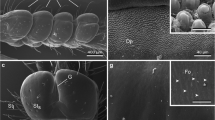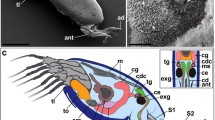Summary
The larva of Distaplia occidentalis bears three cup-shaped adhesive papillae, each with a prominent axial protrusion. At the onset of metamorphosis these organs rapidly evert through fenestrations in the cuticular layers of tunic exposing hyaline caps of adhesive. Additional adhesive material is secreted from collocytes during eversion. The stickiness of the papillae facilitates attachment to a variety of substrates.
Each papilla is composed of more than 900 cells; six different types were identified. The wall of the cup contains about 260 myoepithelial cells with long attenuated processes. These extend from the rim of the cup to the base in the parietal (inner) layer. The apices of the myoepithelial cells are held in place by 11 pairs of specialized anchor cells bearing long bulbous microvilli. When the myoepithelial cells contract they force the axial protrusion forward and transform the papilla into a hyperboloidal configuration. The papilla is innervated by small motor fibers, but sensory fibers were not detected. The adhesive papillae of Distaplia are discussed in relationship to nine other recognizable types of papillae in the ascidians.
Similar content being viewed by others
References
Berrill, N.J.: Tadpole larvae of the ascidians Polycitor, Euherdmania and Polysyncraton. J. Morph. 83, 355–363 (1948a)
Berrill, N.J.: Structure, tadpole and bud formation in the ascidian Archidistoma. J. Mar. Biol. Ass. U.K. 27, 380–388 (1948b)
Berrill, N.J.: Budding and the reproductive cycle of Distaplia. Quart. J. micr. Sci. 89, 253–289 (1948c)
Berrill, N.J.: The gonads, larvae, and budding of the polystyelid ascidians Stolonica and Distomus. J. Mar. Biol. Ass. U.K. 27, 633–650 (1949)
Berrill, N.J.: The Tunicata with an account of the British species. Ray Society 1950
Bone, Q., Mackie, G.O.: Skin impulses and locomotion in Oikopleura (Tunicata: Larvacea). Biol. Bull. 149, 267–286 (1975)
Brewin, B.I.: The growth and development of a viviparous compound ascidian, Hypsistozoa fasmeriana. Quart. J. micr. Sci. 97, 435–454 (1956)
Cavey, MJ., Cloney, R.A.: Fine structure and differentiation of ascidian muscle. I. Differentiated caudal musculature of Distaplia occidentalis tadpoles. J. Morph. 138, 349–374 (1972)
Cavey, M.J., Cloney, R.A.: Fine structure and differentiation of ascidian muscle. II. Morphometrics and differentiation of the caudal muscle cells of Distaplia occidentalis tadpoles. J. Morph. 144, 23–78 (1974)
Cavey, M.J., Cloney, R.A.: Ultrastructure and differentiation of ascidian muscle. I. Caudal musculature of the larva of Diplosoma macdonaldi. Cell Tiss. Res. 174, 289–313 (1976)
Cloney, R.A.: Observations on the mechanism of tail resorption in ascidians. Amer. Zool. 1, 67–87 (1961)
Cloney, R.A.: Cytoplasmic filaments and morphogenesis: Effects of cytochalasin B on contractile epidermal cells. Z. Zellforsch. 132, 167–192 (1972)
Cloney, R.A., Lash, J.W.: Ascidian metamorphosis: The role of the contractile epidermis in tail resorption. Sound film D.B. 262 Educational Development Center, Newton, Mass. (1972)
Grave, C.: Amaroucium pellucidium (Leidy) form constellatum (Verrill) 1. The activities and reactions of the tadpole larva. J. exp. Zool. 30, 239–257 (1920)
Grave, C.: Amaroucium constellatum Verrill. II. The structure and organization of the tadpole larva. J. Morph. 36, 71–101 (1921)
Grave, C.: Molgula citrina (Alder and Hancock). Activities and structure of the free-swimming larva. J. Morph. 42, 453–467 (1926)
Grave, C.: The Botryllus type of ascidian larva. Carneg. Inst. Wash. Pub. 435, 143–156 (1932)
Grave, C.: The larva of Styela (Cynthia) partita: Structure activities and duration of life. J. Morph. 75, 173–191 (1944)
Grave, C., McCosh, G.C.: Perophora viridis Verrill. The activities and structure of the free swimming larva. Wash. Univ. Stud. Scient. Ser. 11, 89–116 (1923)
Grave, C., Riley, G.: Development of the sense organs of the larva of Botryllus schlosseri. J. Morph. 57, 185–211 (1935)
Grave, C., Woodbridge, H.: Botryllus schlosseri pallas: The behavior and morphology of the free swimming larva, J. Morph. 39, 207–247 (1924)
Kott, P.: The ascidians of Australia. II. Aplousbranchiata Lahille: Clavelinidae Forbes and Hanly and Polyclinidae Verrill. Aust. J. Mar. Freshwater Res. 8, 64–110 (1957)
Kott, P.: Antarctic ascidians. National Acad. Sci.-National Res. Council Pub. 1725. Antarctic Res. Series 13, 1–239 (1969)
Kowalevsky, A.: Entwicklungsgeschichte der einfachen Ascidien. Mem. acad. sci. st. Petersb. (7) 10, 1–19 (1866)
Lane, D.J.W.: Attachment of the larva of the ascidian Diplosoma listerianum. Mar. Biol. 21, 47–58 (1973)
Lash, J.W., Cloney, R.A., Minor, R.M.: The effects of cytochalasin B upon tail resorption and metamorphosis in ten species of ascidians. Biol. Bull. 145, 360–372 (1973)
Levine, E.P.: Studies on the structure, reproduction, development and accumulation of metals in the colonial ascidian Eudistoma ritteri Van Name. J. Morph. 111, 105–137 (1962)
Luft, J.H.: Improvements in epoxy resin embedding methods. J. biophys. biochem. Cytol. 9, 409–414 (1961)
Lynch, W.F.: Extrinsic factors influencing metamorphosis in bryozoan and ascidian larvae. Amer. Zool. 1, 59–66 (1961)
Mackie, G.O., Bone, Q.: Skin impulses and locomotion in ascidianan tadpole. J. Mar. Biol. Ass. U.K. 56, 751–768 (1976)
Millar, R.H.: South African ascidians collected by Th. Mortensen, with some additional material. Vidensk Medd. fra. Dansk naturh. Foren. 127, 159–180 (1964)
Millar, R.H.: The biology of ascidians. Adv. Mar. Biol. 9, 1–100 (1971)
Monniot, F.: Ascidies interstitielles des côtes d'Europe. Mem. Mus. natn Hist. nat. (Paris) 35, 1–154 (1965)
Murray, R.G.: The ultrastructure of taste buds. In: The ultrastructure of sensory organs (I. Friedman ed.). Amsterdam: North-Holland Pub. Co. 1973
Reynolds, E.S.: The use of lead acetate at high pH as an electron-opaque stain in electron microscopy. J. Cell Biol. 17, 208–212 (1963)
Richardson, K.C., Jarett, L., Fink, E.H.: Embedding in epoxy resins for ultrathin sectioning in electron microscopy. Stain Technol. 35, 313–323 (1960)
Scott, P.M.: The developmental history of Amaroecium constellatum. II. Organogenesis of the larval action system. Biol. Bull. 91, 66–80 (1946)
Scott, F.M.: The developmental history of Amaroecium constellatum. III. Metamorphosis. Biol. Bull. 103, 226–241 (1952)
Sebastian, V.O.: On Polyclinum indicum, a new ascidian from the Madras coast of India. J. Wash. Acad. Sci. 44, 18–23 (1954)
Trason, W.B.: Larval structure and development of the oozooid in the ascidian Euherdmania claviformis. J. Morph. 100, 509–545 (1957)
Trason, W.B.: The life cycle and affinities of the colonial ascidian Pycnoclavella stanleyi Berrill and Abbott. Univ. Calif. Pub. Zool. 65, 283–326 (1963)
Watanabe, H., Lambert, C.C.: Larval release in response to light by the compound ascidians Distaplia occidentalis and Metandrocarpa taylori. Biol. Bull. 144, 556–566 (1973)
Whitear, M.: Cell specialization and sensory function in fish epidermis. J. Zool. Lond. 163, 237–264 (1971)
Author information
Authors and Affiliations
Rights and permissions
About this article
Cite this article
Cloney, R.A. Larval adhesive organs and metamorphosis in ascidians. Cell Tissue Res. 183, 423–444 (1977). https://doi.org/10.1007/BF00225658
Accepted:
Issue Date:
DOI: https://doi.org/10.1007/BF00225658




